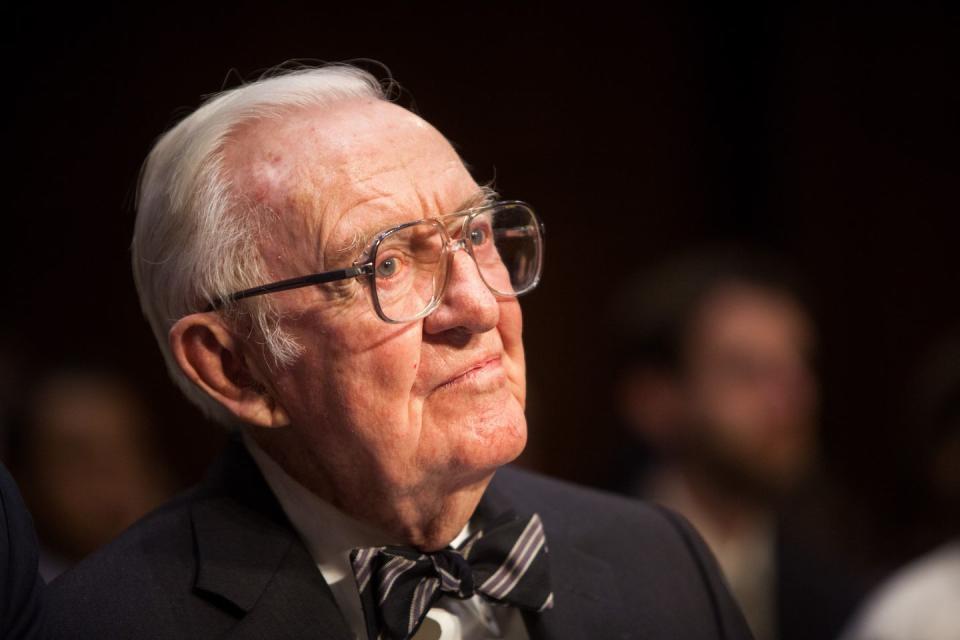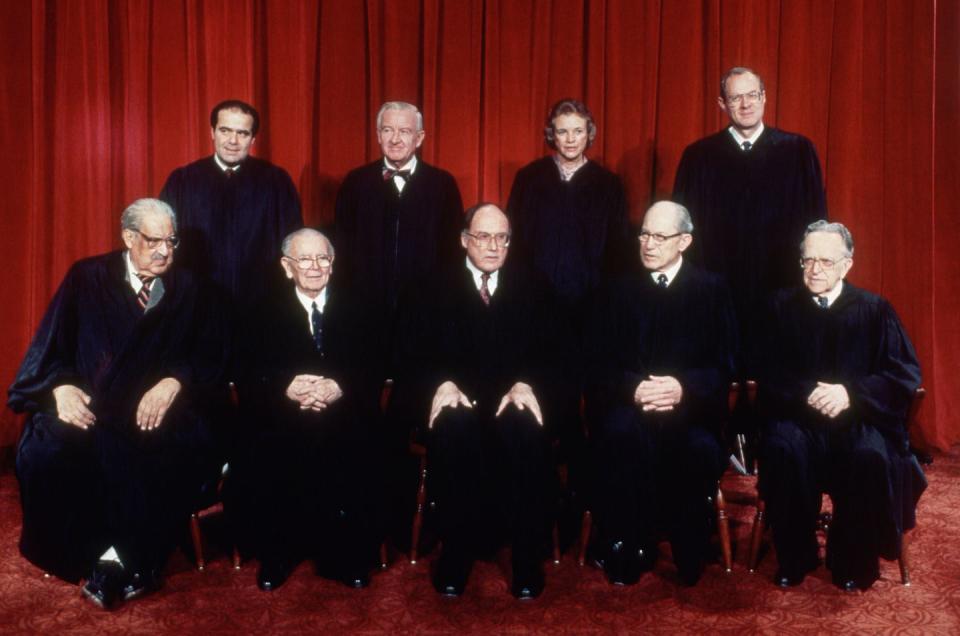John Paul Stevens Saw What Was Coming

It can be argued, and convincingly, too, that things began to go sideways in this country on December 12, 2000, when the Supreme Court handed down its decision in the case of Bush v. Gore, which handed the presidency to George W. Bush. In his dissent, Justice John Paul Stevens saw it coming.
What must underlie petitioners’ entire federal assault on the Florida election procedures is an unstated lack of confidence in the impartiality and capacity of the state judges who would make the critical decisions if the vote count were to proceed. Otherwise, their position is wholly without merit. The endorsement of that position by the majority of this Court can only lend credence to the most cynical appraisal of the work of judges throughout the land. It is confidence in the men and women who administer the judicial system that is the true backbone of the rule of law. Time will one day heal the wound to that confidence that will be inflicted by today’s decision. One thing, however, is certain. Although we may never know with complete certainty the identity of the winner of this year’s Presidential election, the identity of the loser is perfectly clear. It is the Nation’s confidence in the judge as an impartial guardian of the rule of law.
Yes, he surely did.
It can be argued, and convincingly, too, that things began to go sideways in our elections on January 21, 2010, when the Supreme Court handed down its decision in Citizens United v. FEC, which opened the floodgates to corporate money, dark and otherwise, which soon inundated our elections. In his dissent, Justice John Paul Stevens saw it coming.
At bottom, the Court’s opinion is thus a rejection of the common sense of the American people, who have recognized a need to prevent corporations from undermining self-government since the founding, and who have fought against the distinctive corrupting potential of corporate electioneering since the days of Theodore Roosevelt. It is a strange time to repudiate that common sense. While American democracy is imperfect, few outside the majority of this Court would have thought its flaws included a dearth of corporate money in politics.
He was right, both times, just as he was in writing majority opinions in defense of detainees at Guantanamo Bay. In both Rasul v. Bush (2004) and in Hamdan v. Rumsfeld, two years later, Stevens fought to keep the worst excesses of the "war" on terror at bay, and the Constitution reasonably intact against the ministrations of people like Dick Cheney and John Yoo. In Hamdan, Stevens wrote a sentence that ought to ring like the chimes of doom through the present White House.
The Executive is bound to comply with the Rule of Law that prevails in this jurisdiction.
He was a Republican judge, appointed by an unelected Republican president, who lived long enough and served long enough to become the leader of what became the liberal wing of the Supreme Court. How much did things change over his 35 years on the Supreme Court? Appearing with Rachel Maddow on Tuesday night, longtime Supreme Court chronicler Linda Greenhouse pointed out that Stevens was the first Supreme Court justice confirmed after Roe v. Wade was decided and, not only were his confirmation hearings not televised, but Stevens was not asked a single question about abortion.

He lived and served long enough to become one of the legal heroes of the cyber age, as this obituary at ArsTechnica reports.
For example, Stevens penned the 1978 decision that shielded the software industry from the patent system in its formative years. In 1984, Hollywood's effort to ban the VCR failed by just one Supreme Court vote; Stevens wrote the majority opinion. And in 1997, he wrote the majority opinion striking down the worst provisions of the Communications Decency Act and ensuring that the Internet would have robust First Amendment protections.
Indeed, Justice Stevens probably deserves more credit than any other justice for the innovations that occurred under his watch. And given how central those technologies have become to the American economy, Stevens' tech policy work may prove one of his most enduring legacies. In this feature, we review Justice Stevens' tech policy decisions and salute the justice who helped make possible DRM-free media devices, uncensored Internet connections, free software, and much more.
This is unsurprising because his was a restless, questing, voracious mind. His World War II service was as a cryptographer. He came onto the Court as what appeared to be a safe conservative choice. He never lost some of that; in 1989, he wrote a blistering dissent arguing that flag-burning was not protected speech. But, by 1997, he was striking down laws that sought to censor speech on the Internet. His views on affirmative action and, especially, on the death penalty were ever evolving from opposition to support for the former, and from support to opposition to the latter.

In her obituary in The New York Times, Greenhouse attributes much of the momentum behind this evolution to Stevens's collision with the Reagan Administration's disdain for Supreme Court rulings that had preceded it. Stevens apparently had special contempt for Attorney General Ed Meese.
One plausible explanation for Justice Stevens’s growing affinity for the liberal side was his response to the polarizing discourse about the Supreme Court that emanated from the administration of President Ronald Reagan in the mid-1980s. After Attorney General Edwin Meese III criticized a long series of Supreme Court precedents that had interpreted the Bill of Rights as binding not only on the federal government but on the states as well — a foundational premise of 20th-century constitutional law — Justice Stevens took him on directly. The attorney general, he said in a speech to the Federal Bar Association in Chicago in 1985, “overlooks the profound importance of the Civil War and the postwar amendments on the structure of our government.”
Stevens looked after the Reconstruction amendments with special care, especially the 14th Amendment's guarantee of equal protection under the law, a constitutional guarantee that Meese and many conservative legal beagles have tried to defang pretty much ever since it was adopted. (We all should find something we love as much as he loved the 14th Amendment. His other great passion was keeping religion out of the secular government, which also probably set him against the tide.) Stevens was having none of that.
Policies that distinguished among people based on their race were subject to “strict” judicial scrutiny and were almost never upheld. Policies that simply concerned economic interests were subject to minimal scrutiny and were upheld as long as they had a “rational basis.” Policies that treated men and women differently fell somewhere in between, subject to “heightened” judicial scrutiny and required to serve an “important governmental interest.”
Justice Stevens rejected all this. “There is only one Equal Protection Clause,” he declared in 1976, concurring in Craig v. Boren, an early sex discrimination case. “It requires every state to govern impartially.” A straightforward application of that principle was all a court needed, in his view, to decide an equal protection case.
But while Meese et. al. may have been the fuel behind Stevens's evolution, his restless intellect was the engine.
Justice Stevens’s own explanation for why his views had changed was simply that he had learned on the job. “I know that I, like most of my colleagues, have continued to participate in a learning process while serving on the bench,” he said in 2005 at a symposium held at Fordham University Law School to mark his 30th anniversary on the court and 35th year as a judge.
Even after retiring as the second-oldest Supreme Court justice to do so, Stevens kept right on educating himself and the public. He came out publicly against the nomination of Brett Kavanaugh. He was a delightful presence in Ken Burns's documentary on the Prohibition years, reminiscing about that era in his native Chicago and about how his father, a prominent hotelier, bargained with Al Capone to keep crime at bay during an important convention. He wrote three books, the last one a memoir published this spring.
There was always a mind at work there, as living a thing as the Constitution itself. The old codebreaker never stopped looking for the key in every hard question. He almost always found it. He was able to see around corners, was John Paul Stevens, dead now at the age of 99.
Respond to this post on the Esquire Politics Facebook page here.
('You Might Also Like',)

